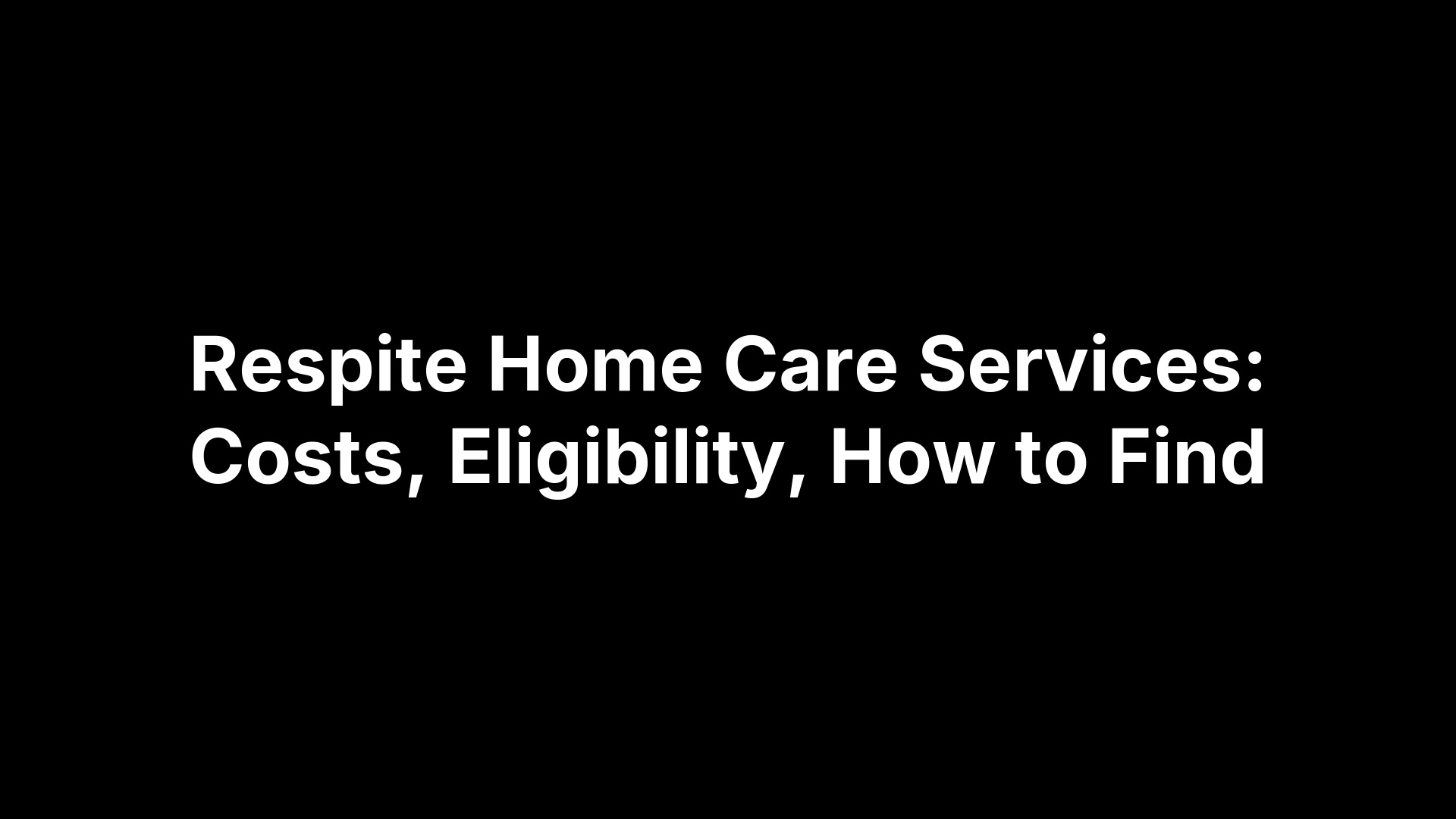Respite Home Care Services: Costs, Eligibility, How to Find


Respite Home Care Services: Costs, Eligibility, How to Find
Caring for a family member at home can be rewarding, but it can also drain you physically and emotionally. You might feel guilty about wanting a break, but taking time for yourself actually makes you a better caregiver. That's where respite home care services come in. These services bring a trained caregiver to your home to look after your loved one while you step away for a few hours, a day, or longer. The person you care for stays in familiar surroundings while you handle errands, visit friends, catch up on sleep, or simply recharge.
This guide walks you through everything you need to know about respite home care. You'll learn what to expect when arranging these services, how much they typically cost, and who might help pay for them. We'll explain eligibility requirements and show you how to find qualified providers in your area. Whether you need a few hours once a week or several days of coverage for a vacation, you'll finish reading with a clear plan for getting the help you need.
Why respite home care services matter
Caregiving puts tremendous stress on your body and mind. Studies show that family caregivers face higher rates of depression, anxiety, and physical health problems than people who don't provide care. You might skip your own doctor appointments, lose sleep, or abandon social activities because caregiving demands consume your time. Over time, this burnout affects your ability to provide quality care. Respite home care services give you the break you need to maintain your own health and continue caregiving for the long term.
Your loved one benefits from respite care too. Professional caregivers bring fresh energy and new perspectives to daily routines. They can introduce activities or conversation topics that spark interest. Many care recipients enjoy the change of pace and the chance to interact with someone new. The safe, familiar environment of home reduces the stress that often comes with moving someone to an unfamiliar location, especially for older adults with cognitive decline or dementia.
Taking regular breaks through respite care isn't selfish; it's essential for sustainable caregiving.
Regular respite breaks help you return to your caregiving duties with renewed patience and focus. You can address your own needs without guilt, knowing your family member receives competent care. This balance protects both your wellbeing and the quality of care your loved one receives over months and years.
How to arrange respite home care
Setting up respite home care services takes planning, but the process is straightforward once you understand the steps. You start by defining your specific needs and then identify qualified caregivers who can meet those requirements. Most families need a few weeks to find the right provider and schedule the first visit, though some agencies offer faster service for urgent situations.
Start by assessing your needs
Before you contact providers, write down what type of help your loved one requires. Does the person need help with bathing, dressing, or using the bathroom? Do they need medication reminders or meal preparation? Can they be left alone for brief periods, or do they require constant supervision? Clear answers to these questions help you find caregivers with the right training level. Someone who needs basic companionship and light housekeeping requires different skills than someone with advanced dementia or complex medical conditions.
You also need to decide when and how often you want coverage. Some families arrange respite care for a few hours one afternoon per week, while others need full-day coverage several times weekly. Consider your own schedule and what would provide meaningful relief. Even four hours can make a difference if you use that time intentionally.
Contact potential providers
Reach out to home care agencies in your area that specifically advertise respite services. Agencies screen their caregivers, handle payroll and taxes, and provide backup coverage if someone calls in sick. You can also hire independent caregivers through referrals from friends or community organizations, though this option requires you to manage background checks, references, and scheduling yourself.
The right caregiver should make both you and your loved one feel comfortable and confident.
Interview at least two or three providers before making a decision. Ask about caregiver training, experience with your loved one's specific conditions, and availability. Request references and check them. Most agencies let you meet the caregiver before the first visit so everyone can get acquainted. This trial meeting helps ensure compatibility and gives you peace of mind when you leave.
Understanding costs and who pays
Respite home care services cost money, and most families pay out of pocket because traditional health insurance rarely covers these expenses. The hourly rates vary widely based on your location, the level of care required, and whether you hire through an agency or independently. Understanding what you'll pay and exploring funding options helps you budget realistically and find ways to offset some expenses.
What respite care typically costs
In-home respite care rates range from $20 to $50 per hour in most U.S. markets, with higher rates in major metropolitan areas. A four-hour afternoon shift costs between $80 and $200, while full-day coverage can run $160 to $400. Agencies typically charge more than independent caregivers because their fees cover background checks, insurance, administrative overhead, and backup staff. Personal care tasks like bathing and toileting usually cost more than basic companionship services.
The cost of respite care represents an investment in your health and your ability to continue caregiving long-term.
Most agencies require a minimum visit length of three or four hours, and some charge extra for evenings, weekends, or holidays. When you compare providers, ask for their complete fee schedule including any additional charges. Factor in how many hours per week you realistically need and multiply that by the hourly rate to estimate your monthly costs. Many families start with just a few hours weekly and adjust their schedule based on what they can afford and what provides meaningful relief.
Payment options and potential assistance
Medicare rarely covers respite home care services except in specific hospice situations where the person has a terminal diagnosis. Some Medicare Advantage plans offer supplemental benefits that include limited respite care hours, so check your loved one's plan details carefully. Medicaid may cover respite care in certain states through waiver programs for seniors or people with disabilities, though eligibility requirements and waiting lists vary significantly by location.
Long-term care insurance policies often include respite care benefits as part of their coverage. Review your family member's policy or call the insurance company to understand what's covered and how to file a claim. Veterans may qualify for respite care through VA programs, including Aid and Attendance benefits. The National Family Caregiver Support Program, administered through Area Agencies on Aging, sometimes provides limited funding or vouchers for respite services based on financial need and availability in your area.
Eligibility and how to qualify
Respite home care services don't typically require strict medical eligibility criteria like some healthcare programs do. Most private agencies accept anyone who needs help with daily activities or supervision at home. However, government-funded programs and insurance coverage come with specific requirements that determine whether you qualify for financial assistance. Understanding these rules helps you identify which funding sources might cover your respite care costs.
Who qualifies for respite care
The person receiving care usually needs help with at least one activity of daily living such as bathing, dressing, eating, toileting, or mobility. Some programs also cover people who require supervision due to cognitive impairment, even if they can handle physical tasks independently. Age requirements vary by program. Medicare hospice respite benefits apply to people with terminal diagnoses and life expectancies of six months or less. Medicaid waiver programs typically serve seniors over 65 or adults with qualifying disabilities.
Income limits affect eligibility for publicly funded respite programs. Many state Medicaid waivers require your loved one's income and assets to fall below specific thresholds. The National Family Caregiver Support Program considers both the care recipient's needs and your status as a family caregiver, with some preference given to caregivers over 60 or those caring for children with disabilities. Private pay options have no eligibility restrictions beyond the caregiver's ability to perform the required tasks safely.
Documentation you'll need
Most programs require documentation from a licensed physician confirming your loved one's diagnoses and functional limitations. You'll need to provide information about current medications, medical conditions, and care needs. Financial assistance programs typically request proof of income through tax returns or benefit statements, plus asset verification through bank statements.
Having your documentation organized before you apply speeds up the approval process significantly.
Gather medical records, insurance cards, identification documents, and any existing care plans before contacting providers or applying for funding. Keep copies of everything you submit because programs may request updates or additional information as they review your case.
How to find and compare providers
Finding qualified respite home care services requires you to tap into multiple resources and evaluate options carefully. You want caregivers who are trained, reliable, and compatible with your loved one's personality and needs. The search process takes effort, but systematic comparison helps you make informed decisions that protect your family member and give you confidence when you step away.
Start your search with trusted sources
Contact your local Area Agency on Aging through the Eldercare Locator to get referrals to reputable agencies and independent caregivers in your area. These organizations maintain lists of vetted providers and can explain which services operate in your community. Ask your loved one's doctor for recommendations based on patients with similar needs. Hospital discharge planners and social workers also maintain contacts with home care agencies they trust.
Search online for home care agencies near you that specifically list respite care among their services. Check each agency's credentials including state licensing, bonding, and insurance coverage. Read reviews on multiple platforms, but focus on patterns rather than individual complaints since every provider occasionally has problems. Friends and family members who have used respite care can offer valuable firsthand insights about local providers.
Evaluate providers systematically
Create a comparison checklist as you interview different agencies and caregivers. Ask each provider about caregiver training requirements, background check procedures, and experience with your loved one's specific conditions. Find out whether they provide backup caregivers if someone calls in sick and how much notice they need for scheduling changes. Request and verify at least three recent references from families with similar care situations.
The best respite provider combines technical competence with genuine warmth and patience.
Compare costs carefully by asking for detailed written fee schedules that include hourly rates, minimum visit requirements, and extra charges for evenings or weekends. Some agencies charge cancellation fees or require contracts, while others offer flexible month-to-month arrangements. Schedule trial visits with your top two or three candidates so you can observe how the caregiver interacts with your family member before committing to regular service.
Next steps
You now understand what respite home care services cost, who qualifies for assistance, and how to find reliable providers in your area. Take action this week by contacting at least two agencies to ask about availability, rates, and caregiver qualifications. Schedule trial visits with candidates who meet your requirements and feel like a good fit for your family member's personality. Start with a few hours weekly if budget concerns limit your options, then adjust your schedule as you discover what truly provides meaningful relief and allows you to address your own needs.
Healthcare organizations that coordinate patient services understand how critical respite care is for long-term caregiver wellbeing. If you work in healthcare operations and need better systems for managing patient logistics and home care coordination, VectorCare streamlines scheduling, vendor management, and service coordination across your entire network. The platform connects care teams, automates workflows, and provides real-time visibility into all patient services.
Remember that asking for help strengthens your ability to care, not weakens it. Every hour you invest in finding the right respite home care services pays dividends in your health and your loved one's quality of care for years ahead.
The Future of Patient Logistics
Exploring the future of all things related to patient logistics, technology and how AI is going to re-shape the way we deliver care.



